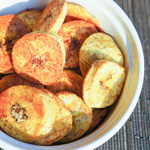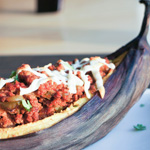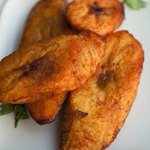Did you know that in the late 19th century the plantain, and its counterpart the banana, were symbols of power, wealth and virility immortalized in still life paintings as the epitome of luxury. Plátanos have come a long way to make it on our plates and as an ingredient in our favorite dishes, but how exactly did they evolve from their origins in Africa to the plátano relleno we find below, overflowing with spicy carne molida and topped with shredded queso blanco? It started with the promise of a new world.
During the 15th and 16th centuries, the mighty plantain migrated to the new colonies in South America with the slaves as an inexpensive, nutritious food to produce. In the 1620’s, it was recorded that more than 30,000 to 40,000 plantains were imported annually to Cartagena, where the resident slave population consumed plantains along with a supplementary diet of beans, cassava, yams, and corn — staples found in today's Latin kitchens.
Known for its fertile land and coastal plains, Cuba became the transit point for Spanish expeditions in the New World, providing ideal tropical climate conditions for plantain and banana cultivation. Introduced into the United States in 1804, plantains and bananas quickly claimed spots on the fruit stand, and regular trade developed around harvests. By the late 19th century, the importation of bananas and plantains continued to increase at a steady rate, and just before the turn of the century, the industry emerged as dominant. The resulting creation of the United Fruit Company in 1898 doubled and tripled plantain and banana cargoes from the islands.
With plantains and bananas becoming less expensive, more familiar, and more widely available, these fruits moved from the still-life painting hanging on the dining room wall to the decorative centerpiece on the dining room table. As importation continued to rise, so did the migration of Latinos to the United States. These populations favored areas inhabited by people with similar backgrounds, as well as locations that had essential provisions available for growing their traditional cuisine. Latin American immigrants chose sites along the southern East Coast because there was available work, and the area offered tropical climes, ideal for the planting of their native ingredients.
As these cultural East Coast hubs grew into celebrated Latin American communities, fusion dishes began to emerge. When T.G.I.Friday’s put a hamburger topped with grilled plantains on their menu, it signaled that the plantain had truly become an integrated part of U.S. food history. Nowadays, plantains can be found on menus around the world, and in celebration of this royal ingredient, we present the plantain we know and love in three different ways: fried, baked and filled.
Enough history; let’s get cooking!

- 2 unripened plantains
- 1/2 tablespoon chili powder
- 1 tablespoon olive oil
- salt and pepper to taste
Click here for the full recipe.
Picadillo-Stuffed Plantains (Plátano Relleno con Carne Molida)
 4 ripe plantains, washed, dried, skin on, slit down center lengthwise
4 ripe plantains, washed, dried, skin on, slit down center lengthwise- 2 tablespoons extra virgin olive oil
- 3 large cloves of garlic
- 1/2 teaspoon crushed red pepper flakes
- 1 small yellow onion
- 1 green bell pepper
- 2 pounds ground beef
- 1/4 cup dry red wine
- 1/2 tablespoon paprika
- 1 cup shredded queso blanco
- salt and pepper, to taste
Click here for the full recipe.

Fried Sweet Plantains (Tajadas)
- 2 overripe plantains
- oil, for frying
Click here for the full recipe.


![Making Mealtime Matter with La Familia: Easy Sofrito [Video]](https://thelatinkitchen.com/wp-content/uploads/2015/10/sofrito-shutterstock__0-500x383.jpg)
![Easy Latin Smoothies: Goji Berry Smoothie [Video]](https://thelatinkitchen.com/wp-content/uploads/2015/12/goji_berry-shutterstock_-500x383.jpg)
















![Fun and Fast Recipes: Fiesta Cabbage Salad [Video]](https://thelatinkitchen.com/wp-content/uploads/2015/11/fiesta_cabbage_slaw-shutterstock_-500x383.jpg)









